













MONASTERY
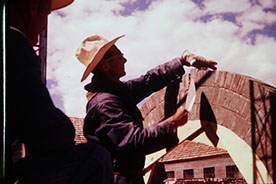
Brick-laying | Winter 1956
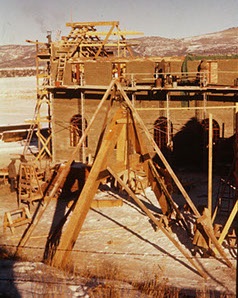
Walls taking shape
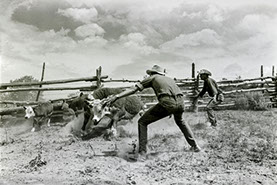
Cattle wrestlers | 1960s
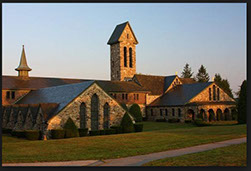
St. Joseph's Abbey
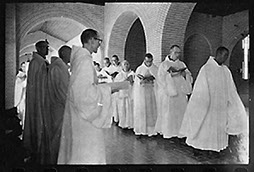
Chapel Procession | 1960s
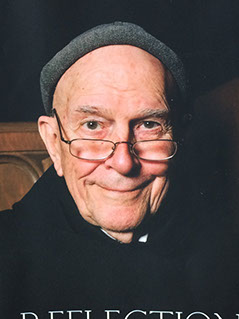
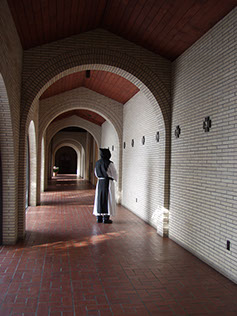
Stations of the Cross | 1980s
HISTORY OF ST. BENEDICT'S MONASTERY
THE LINEAGE OF ST. BENEDICT’S began in 1900, when the community of Petit Clairvaux relocated from Nova Scotia to Rhode Island, where it was renamed Our Lady of the Valley. Following World War II, the community experienced a large influx of vocations, numbering by 1948 one-hundred and thirty-seven. In 1950, fire destroyed the monastery, and the community reestablished itself at Spencer, Massachusetts as St. Joseph’s Abbey.
In the continuing boom of vocations which followed the post-war years, St. Joseph’s founded five new houses, including one in the Rocky Mountains of Colorado: St. Benedict’s Monastery. In the winter of 1956, four monks from St. Joseph’s—soon reinforced by nine additional confreres—arrived in Snowmass, about two-hundred miles west of Denver. For the first two years, the monastery worked out of a brick ranch house, where they lived monastic life while also ranching their 3000-acres and adjusting to the altitude of nearly 8000 feet.
IN 1958, Thomas Keating, the newly-appointed superior of the community, arrived with
several more monks and moved into the new green brick building of St. Benedict’s Monastery. Supplementing their ranch operations, the first generation of monks ventured into the candy industry, which was short-lived due to the unforeseen consequences of the altitude: the monastery’s hard candy cracked when it reached lower elevations. The next industry, a cow-calf operation, proved too much for the monastery’s labor force, and they sold all their cattle, which financed the purchase of ten thousand chickens. In 1967, the monks began selling their eggs to local restaurants, which went on to support the monastery for eighteen years.
In 1961, the community of St. Joseph’s in Massachusetts elected Thomas Keating as their
abbot, recalling him back to Spencer. In his place, Thomas appointed the prior, Joachim Viens, as superior, followed by Michael Abdo in 1967. By 1970, the community had grown large and self-sufficient enough to be raised to an abbey, and Michael Abdo was elected St. Benedict’s first abbot.
THE FLUX which followed the Second Vatican Council unsettled many religious communities, initiating an era of change and a considerable exodus of members from St. Benedict’s—by 1978, only seven remained in the community. The Order’s charism shifted as a result of Vatican II, whose Decree on the Renewal of Religious Life encouraged a return “to the primitive inspiration of the institutes, and their adaptation to the changed condition of our time.”
From an ascetical and penitential identity, contemporary Cistercians strove to recover the contemplative mentality of the early Cistercian fathers, reflected in the Order’s Constitutions as “a monastic institute wholly ordered to contemplation.” Around this time the systematic works of Cistercian figures like Bernard of Clairvaux and Aelred of Rievaulx had begun to be translated into English by Cistercian Publications.
In 1984, Thomas Keating stepped down as abbot of St. Joseph’s after twenty years, and
returned to Snowmass, where he continued his work with Centering Prayer and its organizational arm, Contemplative Outreach. Then, after fifteen years as abbot of St. Benedict’s, Michael Abdo resigned, and on May 29, 1985, the community elected Joseph Boyle as his successor. Fr. Joseph served as spiritual father for more than thirty-three years until his death and was succeeded by Charles Albanese on January 12, 2019.
ONE OF ABBOT JOSEPH’S major projects was the construction of new retreat facilities. After consulting with architects, raising funds, generous donations, and four years of construction, the facilities were completed in the summer of 1995. The Retreat House of St. Benedict’s continues to host Centering Prayer and other group and private retreats, serving as the spiritual home for those seeking to deepen their practice and prayer life.
Before the dust settled too much, an infirmary wing was added to the monastery to address the reality of ageing and infirm members. Another round of architectural planning and fundraising allowed the infirmary to be completed by December of 2000. Five years later, in summer of 2005, the community celebrated the ordination of Brothers Charles Albanese and Micah Schonberger as priests.
Honoring its sixtieth anniversary in 2016, the community of St. Benedict’s Monastery strives to embody the Cistercian tradition in ways appropriate to today. This theme of ‘creative fidelity,’ as Michael Casey calls it, continues to challenge and invigorate contemporary Cistercian life as the community tries to reconcile its spiritual traditions with the signs of the times.
Like every contemporary Cistercian house, the monks of St. Benedict’s face the uncertainties of the future, but within this uncertainty is a call to grace and conversion: looking to the future with faith in God’s providence and a desire to embrace his will. ✜